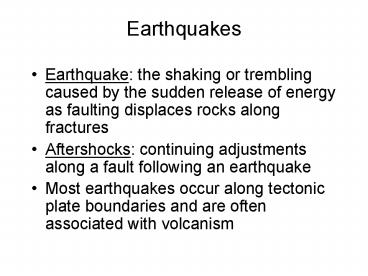Earthquakes - PowerPoint PPT Presentation
1 / 27
Title: Earthquakes
1
Earthquakes
- Earthquake the shaking or trembling caused by
the sudden release of energy as faulting
displaces rocks along fractures - Aftershocks continuing adjustments along a fault
following an earthquake - Most earthquakes occur along tectonic plate
boundaries and are often associated with volcanism
2
Earthquakes
- Elastic rebound theory In an earthquake, rocks
are subjected to stresses which are released as
rocks snap back to their original shape and
position along a fault plane - Earthquake focus the point where fracturing of
rocks begin (also known as hypocenter) - Epicenter the point on the earths surface
directly above the focus
3
ELASTIC REBOUND
4
Earthquake Focus and Epicenter
5
Earthquake Focus Depths
- Earthquakes classified according to depth
shallow focus occur at lt 70 km, intermediate at
70-300 km, and deep focus at gt 300 km below this
depth rocks do not fracture - 90 of all earthquakes occur at lt 100 km
6
Earthquake Focus Depths
7
Earthquakes
- Seismology the study of earthquakes
- Seismic waves energy waves that radiate out from
the point of stored energy release when an
earthquake occurs - Seismograph an instrument that detects, records,
and measures the vibrations produced by an
earthquake - Seismogram the record of an earthquake produced
by a seismograph
8
Seismograph
9
Seismogram
10
Earthquakes
- Earthquake duration reflects the length of the
fault and the time it takes for the stressed rock
to snap back to its undeformed shape - 95 of earthquakes occur at plate margins
- 80 of all earthquakes on earth occur in the
Pacific Ring of Fire - 5 occur within crustal plates, primarily from
localized stresses related to compression along
margins - 150,000 earthquakes recorded each year
11
Pacific Ring of Fire
12
Seismic Waves
- Two main types of seismic waves
- Body waves waves that travel through the solid
body of the earth - Surface waves waves that travel along the
Earths surface, much like waves on water - Body waves occur as either
- P-waves- (primary waves), compressional waves,
the fastest seismic waves, travel through solids,
liquids, and gases - S-waves- slower moving than P-waves, are shear
waves, moving material perpendicular to the
direction of travel, and can not travel through
non-solids that do not have shear strength - Since P-waves move faster they always arrive at
seismic recording stations before S-waves
13
Body Waves P Waves
14
Body Waves S Waves
15
Body Waves
16
Surface Waves
- Surface waves travel along the surface causing a
rolling or swaying motion, in two different
patterns - Rayleigh waves move in an elliptical pattern
much like ocean waves - Love waves move in an S-shaped lateral direction
along the surface
17
Surface Waves
Love Waves
Rayleigh Waves
18
Locating Earthquakes
- Because P-waves move faster than S-waves,
measuring the difference between arrival times
(known as the P-S interval) at recording stations
can provide the distance from an earthquake - Comparing the difference in arrival times at
three different stations allows determination of
the epicenter of an earthquake this is known as
triangulation
19
Earthquake Triangulation
20
Measuring earthquakes
- Intensity a qualitative assessment of earthquake
damage, uses the Modified Mercalli Intensity
Scale, which provides descriptions of earthquake
characteristics at ground level to describe
different levels of intensity - Magnitude measurement of release energy,
determined by measuring the amplitude of the
largest seismic wave recorded on a seismogram,
and plotting that data along with the distance
from the epicenter on the Richter Magnitude Scale
21
(No Transcript)
22
Estimated Intensity of San Francisco
Earthquake, 1906
23
RichterMagnitude Scale
24
Earthquake effects
- Ground shaking
- Liquefaction
- Fire San Francisco, 1906, 90 of damage
- Seismic sea waves Hilo, 1946, 16.5 m
- Ground failure rockslides, avalanches
25
Liquefaction
26
Earthquake prediction
- Although much is now known about how earthquakes
occur and where faults are located, the ability
to predict when they will occur is still not very
well-developed - Seismic risk maps show where earthquakes are
likely and their potential severity help in
planning and preparation
27
Seismic Risk Map of U.S.































